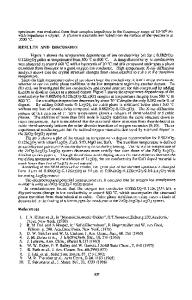Exchange bias and training effect in NiCr 2 O 4 /Cr 2 O 3 composite
- PDF / 403,161 Bytes
- 7 Pages / 584.957 x 782.986 pts Page_size
- 37 Downloads / 385 Views
NiCr2O4/Cr2O3 system with ferrimagnetic spinel and antiferromagnetic transition metal oxide has been firstly synthesized by a chemical co-precipitation method. Magnetic measurements on this system also exhibit the exchange bias (EB) and training effect for the first time. EB effect with evident shift of coercive field and remnant magnetization can be detected at low temperature after field cooling from 350 K. The EB field can reach about 2037 Oe and the magnetization shift is as large as 0.129 emu/g at 10 K. Furthermore, EB effect recedes gradually with temperature increasing and disappears at about 70 K. In this process, EB field decreases with a linear dependence on the magnetization shift. This EB behavior is discussed according to the disordered regions existed at the interface between NiCr2O4 and Cr2O3. In addition, we have analyzed the training effect, which indicates the coexistence of two distinct forms of training mechanism during cycle procedure. One is concerned with an athermal impact resulting in the abrupt single cycle training and the other is gradual reduction of EB field during the subsequent cycles due to the conventional thermal activation mechanism.
I. INTRODUCTION
Exchange bias (EB) effect is usually exhibited in ferromagnetic/antiferromagnetic systems.1,2 It is one of the important phenomena associated with exchange anisotropy. The typical characteristic is horizontal shift of hysteresis loops after the material is cooled with an external field from a higher temperature. EB effect was firstly discovered in passivated Co–CoO nanoparticles by Meiklejohn and Bean about 50 years ago.3 Afterward, it has been intensively investigated in theoretical and experimental aspects due to the extensive applications in the field of advanced technology, for example, data storage as spintronic devices, magnetic recording media and so on.4,5 EB effect can be essentially influenced by the initial temperature and the applied magnetic field during the field cooling process. Thus, training effect is another meaningful characteristic accompanied with EB effect and it reveals a strong dependence on thermal and magnetic histories of EB effect.6 The consecutive hysteresis loop measurement after field cooling presents a decrease in EB field (HEB) with ordinal measurement cycles.7 In general, the understanding of training effect can help to study EB effect, and on other side, the study of training effect may require the exact of EB effect. During the past decades, reports on EB effect were mainly focused on multilayer film system.8 Some particle systems have been studied recently because of
the ferromagnetic–antiferromagnetic exchange interactions, which can be useful to break the superparamagnetic limit in nanoparticles.9,10 In addition, a series of composites containing transition metal particles and their native oxides, for example Ni–NiO,11 have also been emphasized. Nevertheless, the system of transition metal oxides and the corresponding ferrimagnetic spinel is less investigated. NiCr2O4 is a spinel ferrimagnetic material with app
Data Loading...











